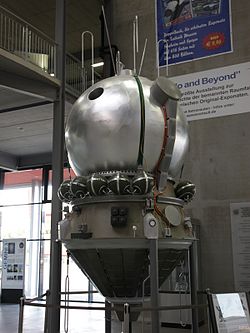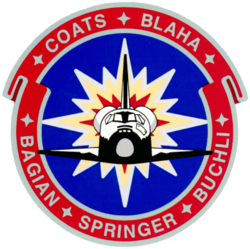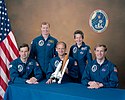STS-30
| STS-30 | |||||
 | |||||
| Uppdrag | 29 | ||||
|---|---|---|---|---|---|
| Rymdfärja | Atlantis (4)[1] | ||||
| NSSDC-ID | 1989-033A[2] | ||||
| Färdens tid | 4 dagar, 56 minuter, 28 sekunder | ||||
| Uppskjutning | |||||
| Startplats | Startplatta 39B vid Kennedy Space Center i Florida | ||||
| Start | 4 maj, 1989, 2:48:59 p.m. EDT | ||||
| Landning | |||||
| Landningsplats | Edwards Air Force Base | ||||
| Landning | 8 maj, 1989, 12:43:27 p.m. PDT | ||||
| Omloppsbana | |||||
| Varv | 64 st[3] | ||||
| Apogeum | 366 km | ||||
| Perigeum | 361 km | ||||
| Banlutning | 28,9° | ||||
| Sträcka | 2,707 miljoner km | ||||
| Besättning | |||||
| Befälhavare | David M. Walker (2) | ||||
| Pilot | Ronald J. Grabe (2) | ||||
| Uppdragsspecialister | Norman Thagard (3) Mary L. Cleave (2) Mark C. Lee (1) | ||||
 | |||||
| Kronologi Rymdfärjeprogrammet | |||||
| |||||
STS-30 var den tjugonionde flygningen i det amerikanska rymdfärjeprogrammet och den fjärde i ordningen för rymdfärjan Atlantis. Den sköts upp från Pad 39B vid Kennedy Space Center i Florida den 4 maj 1989. Efter nästan fem dagar i omloppsbana runt jorden återinträdde rymdfärjan i jordens atmosfär och landade vid Edwards Air Force Base i Kalifornien.
Start och landning
Starten skedde klockan 14:49 (EDT) 4 maj 1989 från Pad 39B vid Kennedy Space Center i Florida.
Landningen skedde klockan 12:43 (PDT) 8 maj 1989 vid Edwards Air Force Base i Kalifornien.
Uppdragets mål
Huvuduppgiften för detta uppdrag var att placera rymdsonden Magellan i en gynnsam startposition. Ombord fanns även tre sekundära experiment som alla hade utförts under tidigare flygningar.
Noterbart
Magellan, vars preliminära mål var att gå in i omloppsbana runt planeten Venus, var den första Amerikanska interplanetära rymdsonden på 11 år.
För första gången under ett uppdrag ersattes en felande GPC (General Purpose Computer) med en medhavd ersättningsmodul. Avbrottet innebar inte några säkerhetsrisker för besättningen eller ej genomförda uppdrag, som emellertid upplevde fler irritationsmoment ombord: Den medhavda Hasselbladskameran felade med en trasig slutare; vattenkranen i pentryt felade, vilket ledde till svårigheter med matlagningen; TAGS-systemet (Text and Graphics Systems - används för att skicka bilder till rymdfarkosten från markkontrollen) fick stängas av på grund av papper som fastnat i en skrivare.
Besättning
- David M. Walker (2), befälhavare
- Ronald J. Grabe (2), pilot
- Norman Thagard (3), uppdragsspecialist
- Mary L. Cleave (2), uppdragsspecialist
- Mark C. Lee (1), uppdragsspecialist
Se även
Referenser
- ^ NASA Space Shuttle Launch Archive Arkiverad 11 december 2013 hämtat från the Wayback Machine., läst 28 juli 2016.
- ^ ”NASA Space Science Data Coordinated Archive” (på engelska). NASA. https://nssdc.gsfc.nasa.gov/nmc/spacecraft/display.action?id=1989-033A. Läst 18 mars 2020.
- ^ Manned Astronautics - Figures & Facts Arkiverad 16 augusti 2016 hämtat från the Wayback Machine., läst 28 juli 2016.
Externa länkar
 Wikimedia Commons har media som rör STS-30.
Wikimedia Commons har media som rör STS-30.
| ||||||||
| ||||||||||||||||||||||||||||||||
Media som används på denna webbplats
Författare/Upphovsman: Pascal (Flickr user: pasukaru76), Licens: CC0
Vostok spacecraft replica at the Technik Museum Speyer, Germany.
STS-28 mission patch
- The STS-28 insignia was designed by the astronaut crew, who said it portrays the pride the American people have in their manned spaceflight program. It depicts America (the eagle) guiding the space program (the Space Shuttle) safely home from an orbital mission. The view looks south on Baja California and the west coast of the United States as the space travelers re-enter the atmosphere. The hypersonic contrails created by the eagle and Shuttle represent the American flag. The crew called the simple boldness of the design symbolic of America's unfaltering commitment to leadership in the exploration and development of space.
STS-29 Mission Insignia
The STS-29 patch was designed to capture and represent the energy and dynamic nature of this nation's space program as America continues to look to the future. The folded ribbon border, the first of its kind in the Shuttle patch series, gives a sense of three dimensional depth to the emblem. The stylistic orbital maneuvering system (ONS) burn symbolizes the powerful forward momentum of the Shuttle and a continuing determination to explore the frontiers of space. The colors of the U.S. flag are represented in the patch's basic red, white, and blue background. In the border, the seven stars between the STS-29 crew names are a tribute to the crew of Challenger.
Five astronauts composed the STS-30 crew. Pictured (left to right) are Ronald J. Grabe, pilot; David M. Walker, commander; and mission specialists Norman E. Thagard, Mary L. Cleave, and Mark C. Lee. The STS-30 mission launched aboard the Space Shuttle Atlantis on May 4, 1989 at 2:46:59pm (EDT). The primary payload was the Magellan/Venus Radar mapper spacecraft and attached Inertial Upper Stage (IUS).
The STS-30 patch depicts the joining of NASA's manned and unmanned space programs. The sun and inner planets of our solar system are shown with the curve connecting Earth and Venus symbolizing the shuttle orbit, the spacecraft trajectory toward Venus, and its subsequent orbit around our sister planet. A Spanish caravel similar to the ship on the official Magellan program logo commemorates the 16th century explorer's journey and his legacy of adventure and discovery. Seven stars on the patch honor the crew of Challenger. The five-star cluster in the shape of the constellation Cassiopeia represent the five STS-30 crewmembers - Astronauts David Walker, Ronald Grabe, Norman Thagard, Mary Cleave and Mark Lee - who collectively designed the patch.







